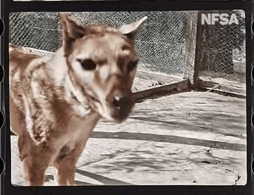Colorized Thylacine Footage




colorized thylacine footage
More Posts from Moonlight-wolf-archive and Others

Thylacine skull By: W. S. Berridge From: The Book of the Animal Kingdom 1910
You know what? That's it.
**Tasmanians your tiger**

Here’s a nice thylacine photograph I personally hadn’t seen before. From Eric Guiler’s book “Tasmanian Tiger: A Lesson to be Learnt.”
Photo caption in the book states that it’s a male at the Beaumaris Zoo.

Halloween art piece:)
Enjoy
Also if you understand the tombstones, kudos!!!!


The tiny skull of a thylacine joey, part of the collection of the Smithsonian National Museum of Natural History. Prior to her premature death, this individual lived alongside her mother and two siblings at the Smithsonian National Zoological Park. [ x ]

⭐️✨🌟💫🐾✨🌟⭐️💫





This is an adult male thylacine taxidermy from the Academy of Natural Sciences in Philadelphia. The most striking aspect of this mount is the little fangs - they may not be anatomically correct, but they’re pretty cute and give him a unique look :)
Unfortunately there is no information about where this specimen came from, the date it was collected or who donated it to the museum.
The mount is in fair to poor condition, with significant damage on the ears, belly, medial aspects of the legs, and near the base of the tail. The white band was placed around the belly in an effort to prevent the skin from cracking further. I did my best to show only his good side, but he’s in need of some serious restorative work. It’s a shame because his facial expression, pose and color are all quite good.
Eternal thanks to @diplotomodon for alerting me to the existence of this specimen!
(My main blog, @sixth-extinction is listed on the images.)
thylacines made good pets?? ;_; they do look like they'd feel soft and glossy to the touch. I'm obsessed with tassie devils, myself, but I'm resigned that they may go extinct before I can travel far enough to see them. I wish I could pet one.
They were obviously not domesticated to the level of having domestication syndrome features (not that I'm sure a marsupial animal *would*), but there are historical records of Tasmanians who kept them as pets, including both white settlers and indigenous people.
Thylacines were somewhat prone to capture myopathy (a stress reaction that causes some animals to die if trapped/captured) and sometimes died after capture, but many did not. If the animals were treated kindly they would generally respond well to attempts to tame them, and this was even more true of orphaned baby thylacines that were raised by humans. There are several stories of people who tamed thylacines very shortly after capture. One such thylacine was let go when she went into season and became restless, and she later introduced her pups to the man she had lived with.
Indigenous people were recorded as having kept them. One indigenous informant stated that they called them "stripey dogs" when they spoke English.
One of my favourite stories was of a white settler family had a large house and kept their thylacine on an extremely long chain in the front so that she could act as a sort of watchdog. This thylacine would watch over the children playing and did not react violently to them even if she was accidentally hit by a ball (she knew that this was an accident) and would give warning of anyone approaching.
The likely reason that thylacines did not become popular household companions was the hate campaign that sprung up around them, stating that they were sheep killers. Once that got to be a big issue and bounties were offered for killing them, people who were taming and raising the animals frequently found them killed, and they gave up on it.
Many of these stories are in Robert Paddle's book, which is an academic study but is extremely readable.

Model of thylacine with mouth agape, displayed at the Kitakyushu Museum of Natural History and Human History in Fukuoka, Japan.
Via @hakubutu on Twitter.

BRUH????
-
 unanocheenrio liked this · 3 weeks ago
unanocheenrio liked this · 3 weeks ago -
 coffee-coyote reblogged this · 3 weeks ago
coffee-coyote reblogged this · 3 weeks ago -
 weirdbandfanpersonyup liked this · 1 month ago
weirdbandfanpersonyup liked this · 1 month ago -
 vikith21 reblogged this · 1 month ago
vikith21 reblogged this · 1 month ago -
 care-or-lynn reblogged this · 1 month ago
care-or-lynn reblogged this · 1 month ago -
 camphorcapstan liked this · 1 month ago
camphorcapstan liked this · 1 month ago -
 bennyfromtv reblogged this · 1 month ago
bennyfromtv reblogged this · 1 month ago -
 cahasan-ace reblogged this · 1 month ago
cahasan-ace reblogged this · 1 month ago -
 cahasan-ace liked this · 1 month ago
cahasan-ace liked this · 1 month ago -
 carnivorous-horses reblogged this · 1 month ago
carnivorous-horses reblogged this · 1 month ago -
 carnivorous-horses liked this · 1 month ago
carnivorous-horses liked this · 1 month ago -
 xephertim reblogged this · 1 month ago
xephertim reblogged this · 1 month ago -
 kabuterizoid liked this · 1 month ago
kabuterizoid liked this · 1 month ago -
 bloodofghostbur reblogged this · 1 month ago
bloodofghostbur reblogged this · 1 month ago -
 bloodofghostbur liked this · 1 month ago
bloodofghostbur liked this · 1 month ago -
 satellitesnotstars reblogged this · 1 month ago
satellitesnotstars reblogged this · 1 month ago -
 barbaress liked this · 1 month ago
barbaress liked this · 1 month ago -
 hazard-115 liked this · 1 month ago
hazard-115 liked this · 1 month ago -
 celeste-tyrrell reblogged this · 1 month ago
celeste-tyrrell reblogged this · 1 month ago -
 celeste-tyrrell liked this · 1 month ago
celeste-tyrrell liked this · 1 month ago -
 nuclearwastedduck liked this · 1 month ago
nuclearwastedduck liked this · 1 month ago -
 clownheadtvreruns reblogged this · 1 month ago
clownheadtvreruns reblogged this · 1 month ago -
 clownheadtvreruns liked this · 1 month ago
clownheadtvreruns liked this · 1 month ago -
 saturnmortis reblogged this · 1 month ago
saturnmortis reblogged this · 1 month ago -
 saturnmortis liked this · 1 month ago
saturnmortis liked this · 1 month ago -
 z3phyr4s reblogged this · 1 month ago
z3phyr4s reblogged this · 1 month ago -
 achillean-daydream liked this · 1 month ago
achillean-daydream liked this · 1 month ago -
 bonzoobel liked this · 1 month ago
bonzoobel liked this · 1 month ago -
 crittercrypt liked this · 1 month ago
crittercrypt liked this · 1 month ago -
 scootszilla reblogged this · 1 month ago
scootszilla reblogged this · 1 month ago -
 onmyway-santafe reblogged this · 1 month ago
onmyway-santafe reblogged this · 1 month ago -
 onmyway-santafe liked this · 1 month ago
onmyway-santafe liked this · 1 month ago -
 alistair-theirins-tits reblogged this · 1 month ago
alistair-theirins-tits reblogged this · 1 month ago -
 alistair-theirins-tits liked this · 1 month ago
alistair-theirins-tits liked this · 1 month ago -
 mail-me-a-snail reblogged this · 1 month ago
mail-me-a-snail reblogged this · 1 month ago -
 randommuffinyt reblogged this · 1 month ago
randommuffinyt reblogged this · 1 month ago -
 randommuffinyt liked this · 1 month ago
randommuffinyt liked this · 1 month ago -
 fideliter liked this · 1 month ago
fideliter liked this · 1 month ago -
 eldritchmirror reblogged this · 1 month ago
eldritchmirror reblogged this · 1 month ago -
 listlesscatpotato liked this · 1 month ago
listlesscatpotato liked this · 1 month ago -
 neon-draws-sometimes reblogged this · 1 month ago
neon-draws-sometimes reblogged this · 1 month ago -
 neon-draws-sometimes liked this · 1 month ago
neon-draws-sometimes liked this · 1 month ago -
 yallmstdve reblogged this · 1 month ago
yallmstdve reblogged this · 1 month ago -
 dolphinsjukebox liked this · 1 month ago
dolphinsjukebox liked this · 1 month ago -
 seeyouonsaturn reblogged this · 1 month ago
seeyouonsaturn reblogged this · 1 month ago -
 tigirl-and-co reblogged this · 1 month ago
tigirl-and-co reblogged this · 1 month ago -
 tigirl-and-co liked this · 1 month ago
tigirl-and-co liked this · 1 month ago -
 wander-over-the-words reblogged this · 1 month ago
wander-over-the-words reblogged this · 1 month ago

Collection of media revolving around the Thylacine
149 posts